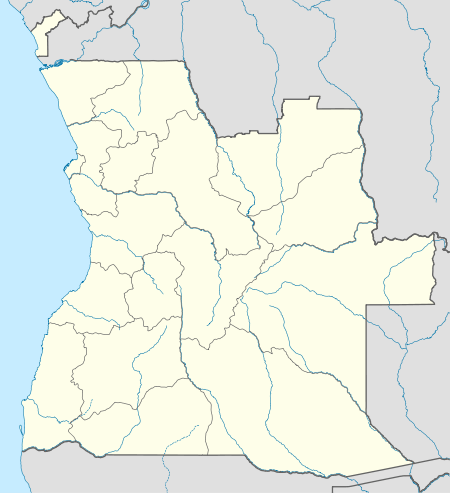Kuito
Coordinates: 12°23′S 16°56′E / 12.383°S 16.933°E
| Kuito Silva Porto | |
|---|---|
| Municipality and town | |
 Kuito Location in Angola | |
| Coordinates: 12°23′S 16°56′E / 12.383°S 16.933°E | |
| Country |
|
| Province | Bié Province |
| Founded | 1750 |
| Area | |
| • Total | 4,814 km2 (1,859 sq mi) |
| Elevation | 1,695 m (5,561 ft) |
| Population (2010) | |
| • Total | 185,302 |
| • Density | 38/km2 (100/sq mi) |
| Time zone | WAT (UTC+1) |
| Area code(s) | (+244) 48 |
| Climate | Cwb |
Kuito (also Cuito) is a city located in central Angola. It is the administrative capital of Bié Province. Under Portuguese rule until 1975, it was called Silva Porto. Kuito was under siege in 1993/94 and again in 1998/99 by the rebel forces from UNITA. Many buildings in Kuito are still heavily damaged as a result of these sieges.
History
The city of Kuito is built in the historical heart of the Ovimbundu kingdom. The ruler of the Ovimbundu was named Viye and he married a Songo woman named Cahanda. Together they built the city and later the Portuguese would name the Bié Province after the ruler.[1] The Ovimbundu were known for selling captives from neighbouring tribes to the European slave traders which made the area an ideal location for the slave business and brought colonists to the area. The Portuguese "founded" the city in 1750.[2] They later called it Silva Porto after António da Silva Porto who built his home embala Belmonte in the area.[3] The pleasant climate in the Bié Province was attractive to Portuguese settlers and many made their home in Silva Porto in the early 1900s when the Benguela Railway connected the city to the coast.
Kuito had a long history of violence starting with the African slave trade and tribal warfare. Later in the 1960s the Portuguese used the town of Silva Porto as a training centre for training black Portuguese Army soldiers to send Northern Portuguese Angola in order to fight the nationalist guerrillas, during the Portuguese Colonial War.
After independence from Portugal in 1975, Kuito saw its worst times on 6 January 1993 when UNITA, during the Angolan Civil War, laid siege of the city for over 9 months and over 30,000 people were killed, both from war effects and starvation. Nobody was permitted to enter or leave the city for 9 months and the city suffered heavy damage. UNITA was eventually driven from Kuito and a second attempt was made to capture the city in 1998 using huge artillery and tanks.[4]
Climate
The town sits on the eastern flank of the Bie Plateau. The climate is unusually cool for its tropical location. The average annual temperature is 18 °C, largely due to its high altitude. The coolest period is May to August when almost no rain falls. September and October are the hottest months with a little rain. Heavy rain falls in the main rainy season November to April.
| Climate data for Silva Porto (Kuito) | |||||||||||||
|---|---|---|---|---|---|---|---|---|---|---|---|---|---|
| Month | Jan | Feb | Mar | Apr | May | Jun | Jul | Aug | Sep | Oct | Nov | Dec | Year |
| Record high °C (°F) | 29 (84) |
28 (82) |
28 (82) |
29 (84) |
28 (82) |
27 (81) |
27 (81) |
30 (86) |
31 (88) |
31 (88) |
29 (84) |
28 (82) |
31 (88) |
| Average high °C (°F) | 25 (77) |
24 (75) |
24 (75) |
24 (75) |
24 (75) |
23 (73) |
24 (75) |
26 (79) |
28 (82) |
26 (79) |
24 (75) |
23 (73) |
25 (77) |
| Daily mean °C (°F) | 19 (66) |
19 (66) |
19 (66) |
18 (64) |
17 (63) |
14 (57) |
15 (59) |
17 (63) |
20 (68) |
19 (66) |
19 (66) |
18 (64) |
18 (64) |
| Average low °C (°F) | 14 (57) |
14 (57) |
15 (59) |
13 (55) |
10 (50) |
6 (43) |
7 (45) |
9 (48) |
12 (54) |
13 (55) |
14 (57) |
14 (57) |
12 (54) |
| Record low °C (°F) | 3 (37) |
7 (45) |
5 (41) |
0 (32) |
−1 (30) |
−5 (23) |
0 (32) |
0 (32) |
3 (37) |
6 (43) |
6 (43) |
5 (41) |
−5 (23) |
| Average precipitation mm (inches) | 193 (7.6) |
196 (7.72) |
203 (7.99) |
76 (2.99) |
10 (0.39) |
0 (0) |
0 (0) |
3 (0.12) |
23 (0.91) |
109 (4.29) |
193 (7.6) |
221 (8.7) |
1,227 (48.31) |
| Source: weatherbase.com [5] | |||||||||||||
Transportation
Kuito is served by the Benguela railway that once connected the inland provinces to the coast. The actual railway station serving Kuito is located a few kilometers north of the town. The railway is expected to be repaired in the next few years. There are also direct flights from Luanda.
See also
Notes and references
- ↑ T. Ernest Wilson, Angola Beloved p. 32.
- ↑ John Marcum, The Angolan Revolution vol I (1950-1962): The Anatomy of an Explosion. p. 102n.
- ↑ Henry W. Nevison. A Modern Slavery p. 84.
- ↑ Martin James, Historical Dictionary of Angola
- ↑ "Weatherbase: Historical weather for Silva Porto, Angola". Retrieved February 13, 2010.